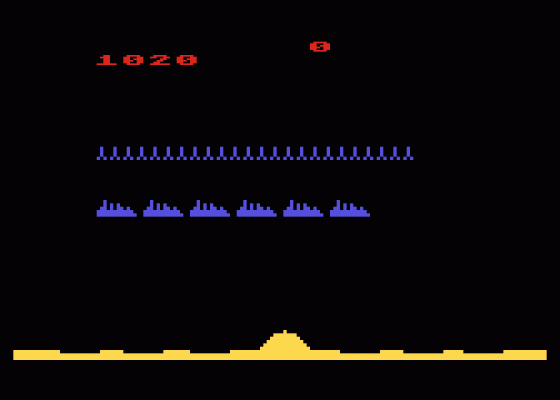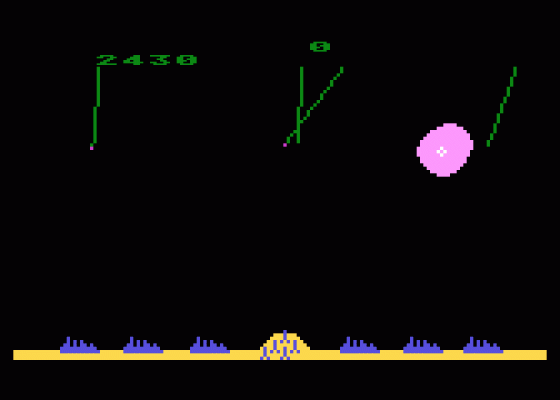Missile Command
So it arrives, the moment we all dread: Armageddon! High above the panic-stricken inhabitants of Planet Earth, the stratosphere is being ripped asunder by thousands of gleaming projectiles. Four minutes left in which to construct a fall-out refuge of old paperbacks and lay in a few warm coats for the nuclear winter...
But no! For this is a wishfulfilment fantasy (of sorts). Deep underground, carefully maintained mechanisms awaken. Hunched figures tense over radar screens and delicate electronic fingers probe the sky. This is Missile Command, central control centre for the widely flung net of Anti-Ballistic Missile sites. Before long the incoming warheads are just so many expanding clouds of debris in the near-vacuum of the upper atmosphere. Sighs of relief? No time. Because here comes the second strike...
Galosh
Of course we all know there are no ABM systems in the world, barring a ring of rather obsolescent Galosh sites around Moscow. They were all banned by the SALT I agreement, good thing too. That proved no deterrent to games designers, and around 1978 the arcades began to resonate to frustrated screams of 'Sod it, I've been MIRVed!' and 'Curses! Three cities taken out!" And so the language of the strategic planners found its way to street level.

Surprisingly, few people found the subject matter of Missile Command too forbidding, mainly because it was the best game around. Pre-Missile Command games, if we can think that far back, were nearly all variations on the classic Space Invaders scenario, including Galaxian Ambush, and many clones. As any fule kno, in these, lots of little malevolent wriggly things descend from the screen-top, usually dropping bombs, boiling oil, flower-pots and other paraphernalia on the way. The player is equipped with a little upward-firing laser gun which can be trundled right/left. Controls, on the arcade variants at least, are three push-buttons.
I harp on these older games because Missile Command was something of a fundamental departure from this formula. Earlier games were basically one dimensional - only the player's horizontal co-ordinate which counted. Missile Command targeting ranges over the entire screen. Both X and Y axes come into play, and that's a whole new ball game.
When the game opens, you are equipped with one or more ABM sites, protecting six identikit cities, all this at the base of the screen. Enemy missiles come in at any angle from above, and to destroy one, an ABM must be exploded in its path. The player moves a cross-hair around the screen, and when the fire-button is pressed, the ABM sets out for the current cross-hair position, where it detonates - a 'fire and forget' system.
Trackball

Push-button control just wasn't good enough for the two-dimensional movement involved, so Atari introduced an entirely new user interface, the trackball. Nothing more than a plastic sphere mounted on a base of rheostats, the trackball was the fore-runner of the desktop 'mouse'. It's a brilliantly simple idea, and the smoothness of movement you get playing Missile Command must have contributed hugely to its popularity.
So back to the action. Wouldn't be so bad if the incoming mail was single warhead, but in line with modern ICBM technology, the missiles are frequently MIRVs (Multiple Independent Re-entry Vehicles). This means that if you let them get too low, they split into a number of independently targetted warheads, which are an absolute pig to clear. Up goes the megadeath count. Killer satellites have a nasty habit of trundling across the screen and MIRVing.
Worse - for the arms race continues - are the MRVs (Manoeuvrable Re-entry Vehicles); these little devils dodge your counter-explosions and force you to waste defence missiles seeing them off. At the end of each wave of incoming missiles, bonuses are paid out on the basis of unused ABMs and living cities. If there are no living cities, you, and presumably civilisation as we know it, have lost.
Defender
You have to defend your ABM sites as well as the cities, and this is where the original arcade game and the computer variants differ. In the arcade there were three sites, with a separate fire button for each, which made life more complex. If a missile site was taken out, it stayed taken out until the end of the frame - Micro variants generally have only one site, and if it's zapped it usually only means that defensive operations are suspended for a second or two.
Simplicity, right down to the elegant trackball, is probably the key to Missile Command's success. But is there more? Does this game fulfil some inner need in people, a response to the feelings of impotence brought on by the prospect of all-out nuclear killozap? For Missile Command, for a short period of time, gives us the illusion that we can protect ourselves. Truly, we can be heroes, just for one play...
Other Reviews Of Missile Command For The Atari 400
An Atari Assortment
A batch of Atari allsorts are tasted by Bob Chappell - which are his favourite ones?


 22nd August 1984
22nd August 1984


